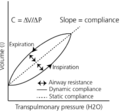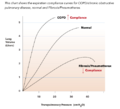Lung Compliance
Original Editor - Shalini Varadhan
Top Contributors - Kapil Narale, Shalini Varadhan, Lucinda hampton, Kim Jackson, Uchechukwu Chukwuemeka and Mohit Chand
Introduction[edit | edit source]
Pulmonary compliance, a measure of the expansion of the lung, is critical to the proper function of the respiratory system. Lung compliance can be calculated by dividing volume by pressure.
Factors affecting lung compliance include elasticity from the elastin in connective tissue and surface tension, which is decreased by surfactant production.
Lung compliance participates in the lung-chest wall system by opposing the outward pull of chest wall compliance.
The net compliance (lung-chest wall system) allows the lungs to achieve appropriate functional residual capacity, the volume remaining after passive expiration[1].
Transmural Pressures[edit | edit source]
The compliance of the lung describes the relationship between the transmural pressure (ie pressure passing through a wall eg hollow structure) across the lung compared with organ's volume. By transmural pressure we mean the relative pressure between the alveoli compared with that in the intrapleural space. Positive transmural pressures mean greater alveolar pressures than intrapleural pressures.
- Although positive transmural pressures are required to expand the lung, they are not achieved by generating positive alveolar air pressures. Rather, lung expansion is achieved by generating progressively negative pressures within the intrapleural space. Conceptually, one can think of this as inflating a balloon not by breathing into it, and thus increasing the internal pressure above that of atmospheric pressure, but rather by placing it within a chamber and generating a progressive vacuum around the balloon. Appreciation of this important feature of lung expansion is critical for understanding how lung expansion can be achieved given the fact that the lung is not physically attached to the chest wall and is instead separated by the intrapleural space.
- Similar to a balloon, the lungs expand by generating positive transmural pressures. However, unlike a balloon these positive transmural pressures are generated by creating negative surrounding pressure within the intrapleural space. As shown, the pressure of air within the lungs remains equivalent with that of the atmosphere at the peak inspiration or expiration[2].
Function[edit | edit source]
Compliance of the respiratory system describes the expandability of the lungs and chest wall. There are two types of compliance: dynamic and static.
- Dynamic compliance describes the compliance measured during breathing, which involves a combination of lung compliance and airway resistance. Defined as the change in lung volume per unit change in pressure in the presence of flow.
- Static compliance describes pulmonary compliance when there is no airflow, like an inspiratory pause. Defined as the change in lung volume per unit change in pressure in the absence of flow.
Pressure-volume curves are common schemes to express the relationship of dynamic and static compliance where the slope is compliance.
Important Factors
The physical basis of the lung's elastic recoil and the shape of its compliance curve are the result of two basic components of pulmonary tissue. The first is the protein elastin which is a major component of the pulmonary interstitial connective tissue and the second is surface tension of alveolar fluid.
- Elastin: a highly stretchable protein which is found widely throughout the pulmonary interstitial connective tissue. Molecularly, elastin proteins naturally tend toward a globular structure but can be stretched if a force is applied; however, once the protein is fully extended the molecule is highly resistant to further stretching, similar to a rubberband. The elastic recoil of the lung and its tendency to have a higher compliance at lower lung volumes is in large part explained by the combined action of the elastin fibers spread throughout the pulmonary interstitium. These fibers serve to powerfully recoil the lung and only stretch when a force is applied; however, once the lung is stretched to large volumes, these proteins become highly resistant to further stretching.
- Surface Tension: a physical property of water which causes surfaces of water to achieve the smallest possible area. Surface tension arises from the energetic preference of water molecules to interact with one another through hydrogen-bonding rather than with air. Individual alveoli all contain a highly thin inner lining of water-based fluid whose surface tension exerts a collapsing force on the alveolus. This is because smaller alveolar volumes would naturally reduce the surface area of the thin fluid lining.
The combined force of surface tension throughout the lung's alveoli serve as a powerful contributor to the elastic recoil of the lung.
Increased lung volumes would require expansion of individual alveoli which is highly resisted by the surface tension of the alveolar fluid inner lining. In fact, the recoiling force of alveolar surface tension is so powerful that special surfactant chemicals must be synthesized and secreted into the inner lining fluid to reduce the surface tension. Failure to produce these surfactants is an important contributor to major pulmonary pathologies eg Neonatal Respiratory Distress Syndrome.[2]
Sub Heading 3[edit | edit source]
Resources[edit | edit source]
- bulleted list
- x
or
- numbered list
- x
References[edit | edit source]
- ↑ Edwards Z, Annamaraju P. Physiology, Lung Compliance.2020 Available from:https://www.statpearls.com/articlelibrary/viewarticle/24496/ (accessed 17.4.2021)
- ↑ 2.0 2.1 Pathway medicine Lung compliance Available from:http://pathwaymedicine.org/lung-compliance (accessed 17.4.2021)
.4
Compliance Diagram[edit | edit source]
The diagram relates the lung volume differs to changes in the trans pulmonary pressure. It differs for inspiration and expiration.
Compliance Curve[edit | edit source]
The two compliance curves are:
- Inspiratory Compliance curve
- Expiratory Compliance curve
Types of Compliance[edit | edit source]
Dynamic Compliance :is defined as the change in lung volume per unit change in pressure in the presence of flow.
Static Compliance : is defined as the change in lung volume per unit change in pressure in the absence of flow.
Important Factors[edit | edit source]
The two important factors of Lung compliance :
Elastic Fibers : More fibers in the tissue lead to ease in expand-ability and there for compliance.
Surface tension : It is decrease due to the production of surfactant to prevent collapse.4
Hysteresis[edit | edit source]
Hysteresis is the term used to describe the difference between inspiratory and expiratory compliance. Lung volume at any given pressure during inhalation is less than the lung volume at any given pressure during exhalation.3
Hysteresis is present in both static and dynamic lung compliance curves
Hysteresis develops due to:
- The effect of surfactant
- Relaxation of lung tissue
- Recruitment and derecruitment of alveoli
- Gas absrption during measurement
- Differences in expiratory and inspiratory air flow (for dynamic compliance)
Factors which affect compliance can be divided into chest wall factors and lung factors:
| Lung compliance | Chest wall compliance |
Increased lung compliance
|
Increased chest wall compliance
|
Decreased static lung compliance
Decreased dynamic lung compliance
|
Decreased chest wall compliance
|
Related articles[edit | edit source]
Lung volumes-physiopedia
Lung compliance
References[edit | edit source]
- Iotti, G., & Braschi, A. (1999). Measurements of respiratory mechanics during mechanical ventilation. Rhäzüns, Switzerland: Hamilton Medical Scientific Library.
- Harris, R. Scott. "Pressure-volume curves of the respiratory system." Respiratory care 50.1 (2005): 78-99.
- Rahn, Hermann, et al. "The pressure-volume diagram of the thorax and lung." American Journal of Physiology-Legacy Content 146.2 (1946): 161-178.
- https://www.us.elsevierhealth.com/guyton-and-hall-textbook-of-medical-physiology-9781455770052.html
- https://www.ncbi.nlm.nih.gov/books/NBK554517/
- https://med.libretexts.org/Bookshelves/Anatomy_and_Physiology/Book%3A_Anatomy_and_Physiology_(Boundless)/21%3A_Respiratory_System/21.6%3A_Factors_Affecting_Pulmonary_Ventilation/21.6B%3A_Factors_Affecting_Pulmonary_Ventilation%3A_Compliance_of_the_Lungs
- http://rc.rcjournal.com/content/respcare/50/1/78.full.pdf









